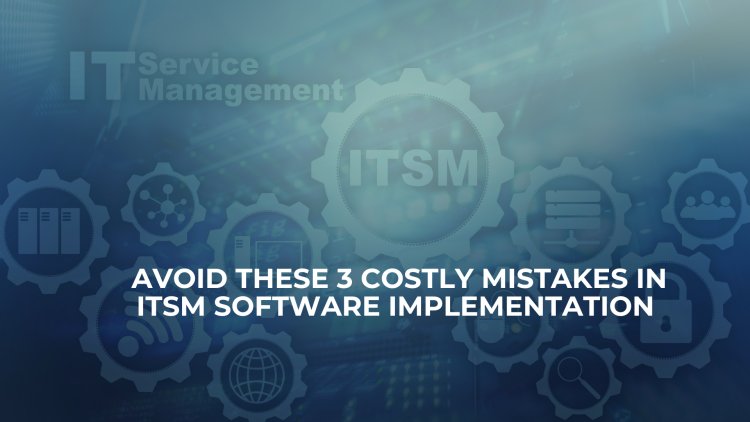Avoid These 3 Costly Mistakes in ITSM Software Implementation
Share this Post to earn Money ( Upto ₹100 per 1000 Views )

Modernizing your legacy ITSM system with advanced, AI capabilities can be a game-changer for your enterprise. When done right, a modern ITSM system can help you boost productivity of your IT team and eliminate bottlenecks in delivering services to your employees. However, most businesses fail to get the maximum value from their initiatives as they oversee some critical challenges in the implementation. To help you maximize value from your ITSM system implementation, we will take you through three most common mistakes enterprises make during the implementation process.
Why should you implement an ITSM system?
ITSM is no more a ‘nice-to-have’ system for enterprises. A modern ITSM help you follow a structured approach to delivering IT services. Legacy ITSM systems may have some limitations, but if modernized, they help boost teams' productivity and meet customer expectations efficiently.
Here are the benefits that IT departments get by investing in ITSM Software:
-
Improved Efficiency: An efficient ITSM software powered with AI can automate daily tasks such as troubleshooting and ticketing, reducing manual processes, leading to faster delivery of service and less downtime
-
Increased Productivity: AI powered IT service management software frees up time for your IT teams enabling them to put their focus on strategic initiatives and boosting overall productivity.
-
Scalability and Flexibility: Your ITSM software scale up and down based on your business needs – handling larger user bases, adding new service or adapting to changes.
-
Cost Reduction: AI powered ITSM solution automates the processes reducing the manual process cutting operational costs and optimizing resource allocations.
-
Reducing Risks: ITSM software powered with AI helps enterprises identify potential issues before they occur, leading to more secure environment minimizing risks related to security, regulatory and downtime issues.
Overall, an effective IT service management software is not only a tool but also a strategy investment that helps enterprises stay competitive in a dynamic market. However, before you start realizing the benefits of ITSM software, you need to implement it effectively.
Common mistakes in implementing ITSM:
Like other implementation processes, ITSM software implementation also comes with its own challenges and risks. However, the best part is that if you follow a strategic approach, you can avoid those mistakes or at least minimize their impacts on the implementation. Here are the three common mistakes businesses often do while implementing ITSM:
1. Excluding stakeholders
Including all the stakeholders in decision making is critical for successfully implementing the ITSM software. You need to consider their requirements, impact of implementing the ITSM on their operations, expected ROI, etc. Every stakeholder should contribute at strategical, tactical, and operational levels. Not aligning with the stakeholders would result in delayed implementation projects or, in the worst-case scenario, shelving it altogether.
Let's explore how to avoid this pitfall
-
Connect with the stakeholders to secure their buy-in from the initial phase by highlighting how an effective IT service management software stands out in your organization.
-
Communicate daily with your leaders about the implementation phases and how they are aligned with business objectives. Ensure that management is part of the entire implementation journey
2. Unclear IT Service Management Solution objectives
An effective IT service management software always be aligned with the business objectives. You need to set ITSM software objectives beforehand to understand what you will achieve after implementing IT service management software before deploying resources.
Vague objectives will lead you to vague outcomes, so you should avoid creating such as kind of vague goals for your ITSM implementation. ITSM implementation objectives should be aligned with business goals otherwise IT department will risk working in siloes and missing opportunities.
Let's explore how to avoid this challenge
-
Set realistic and measurable objectives.
-
Before setting objectives for ITSM system, consider your business objectives first.
-
Make sure to have regular reviews and make required changes wherever they are required to keep objectives aligned.
3. Integration challenges and technical complexity
Integrating various tools within your existing IT infrastructure can be a technically challenging task. Technical complexities could be integration of third-party applications, various APIs and data formats. Moreover, transforming your legacy system to new AI-powered ITSM software involves adapting new change management challenges such as compatibility issues, protocols, data formats, and infrastructure. Moreover, migrating data from existing infrastructure to new one comes with a different set of problems. If you get it done wrong in the first place, the entire ITSM software implementation will lead to data loss and corrupting data, which will finally lead to loss.
Let's explore ways to avoid this challenge:
-
Start with strategic planning, including all technical aspects in every phase of implementation. This will help enterprises to comprehend the probable technical complexity and integration challenges that can appear in different phases.
-
Technology partners can help you plan and implement the ITSM system. You can connect with experts like Saxon AI for successful implementation.
-
Set standard practices and best methodologies to follow for ITSM implementation.
-
Ensure your whole implementation process is divided into smaller and manageable phases so that you can reduce the complexity and manage them better.
These 3 common ITSM software implementation challenges can be avoided easily if you follow the steps mentioned above. If you want to implement modern, AI-powered ITSM application, explore here.

 Neeraj
Neeraj 















